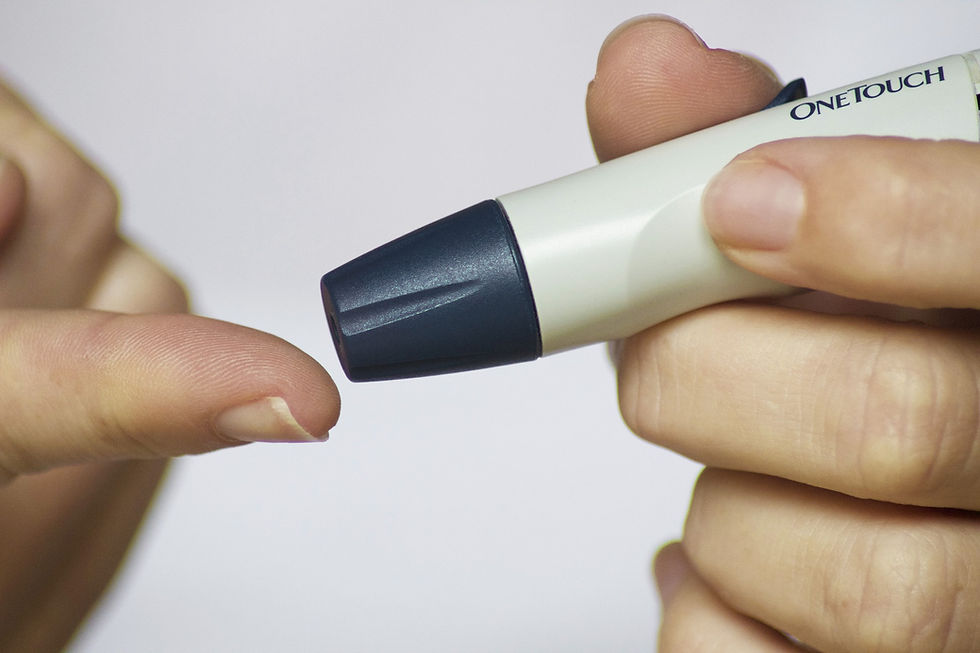How exactly does exercise help control blood sugar?
- Vignesh Ananthraj

- May 26
- 3 min read
Blood sugar control isn’t just a concern for people with diabetes—it’s a cornerstone of long-term health. Even among those without the condition, repeated sharp spikes in blood glucose can quietly damage blood vessels⁽⁶⁾, accelerate ageing, and raise the risk of cardiovascular disease⁽⁷⁾.
While food typically gets most of the attention, one of the most powerful—and underutilised—tools for regulating blood sugar is movement. And it doesn’t require hours in the gym. From short post-meal strolls to consistent weekly workouts, physical activity helps the body use glucose more efficiently, with or without insulin, and smoothens the inner workings of metabolism over time.
In a world increasingly shaped by ultra-processed diets and sedentary routines, understanding how exercise supports blood sugar control could be one of the most accessible steps toward a longer, healthier life. Here are four science-backed ways it works:
1. Muscles can absorb glucose without Insulin
One of the defining issues in type 2 diabetes is that the body becomes resistant to insulin—the hormone that typically ferries glucose from the bloodstream into cells. Remarkably, exercise gives muscles a workaround: during physical activity, muscle cells can absorb glucose directly from the blood, even without insulin.
This happens thanks to GLUT4 transporters, which move to the surface of muscle cells during exercise and act like high-powered vacuums for blood sugar⁽¹⁾. This mechanism is particularly beneficial for people with insulin resistance, but it also benefits anyone trying to maintain steady glucose levels.

2. Physical activity enhances insulin sensitivity
Beyond bypassing insulin temporarily, exercise also helps your body respond better when insulin is present. Regular movement increases both the number and sensitivity of insulin receptors in muscle tissue, enabling more efficient glucose uptake and reducing overall insulin demand.

According to the American Diabetes Association, this improved insulin sensitivity can persist for up to 48 hours after exercise⁽²⁾—meaning that even a few workouts per week can offer lasting metabolic benefits.
3. Post-Meal walks significantly reduce glucose spikes
One of the easiest ways to blunt post-meal blood sugar surges? A walk.
A 2022 meta-analysis published in Sports Medicine found that standing or walking for just 2 to 5 minutes after eating led to measurable reductions in postprandial glucose levels⁽³⁾. Light movement provides an immediate destination for circulating glucose: your working muscles.
You don’t need a treadmill or a gym membership to benefit. A casual stroll after dinner may be one of the simplest and most effective health interventions available.

4. Long-term exercise rewires your metabolism
While the short-term benefits of exercise on blood sugar are significant, the long-term effects are even more profound. Consistent physical activity changes the way your body manages energy at a cellular level.
Over time, regular exercise boosts insulin sensitivity, increases GLUT4 expression⁽⁴⁾, and enhances the capacity of muscle cells to store glycogen. These adaptations lead to greater “metabolic flexibility”—your body becomes more adept at switching between carbohydrates and fats depending on energy demands⁽⁵⁾. This isn’t just good for glucose control; it’s foundational for overall metabolic health.

Movement as Medicine
Controlling blood sugar isn’t only about avoiding desserts or counting carbohydrates—it’s about making your body better at doing what it’s designed to do. Movement, even in small doses, helps muscles act like glucose-hungry sponges, reducing the burden on your bloodstream and your pancreas.
Over time, exercise doesn’t just improve how your body handles sugar—it fundamentally transforms your metabolism into a more flexible, resilient system. In today’s sedentary, high-sugar world, movement becomes more than a fitness strategy. It becomes medicine. And that prescription can start with something as simple as a short walk after dinner.

References
Richter EA, Hargreaves M. Exercise, GLUT4, and skeletal muscle glucose uptake. Journal of Physiology, 2013.
American Diabetes Association. Physical Activity and Blood Glucose.
Duvivier BMFM et al. Light physical activity after meals reduces glucose and insulin responses: a meta-analysis. Sports Medicine, 2022.
Sylow L et al. Exercise stimulates muscle GLUT4 translocation in insulin-resistant mice independently of AMPK and Akt. Journal of Clinical Investigation, 2017.
Hawley JA, Lessard SJ. Exercise training-induced improvements in insulin action. Endocrinology and Metabolism Clinics, 2008.
Node K, Inoue T. Postprandial hyperglycemia as an etiological factor in vascular failure. Cardiovascular Diabetology, 2009.
Ceriello A. Postprandial Hyperglycemia/Hyperlipidemia and Cardiovascular Disease. The American Journal of Cardiology, 2007.

.png)




Comments